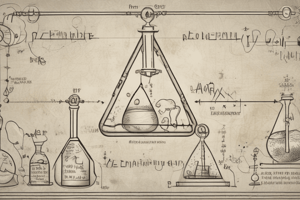Podcast
Questions and Answers
What is the primary process involved in a chemical reaction?
What is the primary process involved in a chemical reaction?
- The change in physical state of reactants
- The formation of chemical bonds
- The breaking and forming of chemical bonds (correct)
- The combustion of reactants
What is the purpose of coefficients in a chemical equation?
What is the purpose of coefficients in a chemical equation?
- To ensure equal numbers of atoms of each element (correct)
- To represent the reactants and products
- To indicate the direction of the reaction
- To indicate the physical state of reactants and products
What type of chemical reaction involves the combination of two or more reactants to form a single product?
What type of chemical reaction involves the combination of two or more reactants to form a single product?
- Replacement Reaction
- Combustion Reaction
- Decomposition Reaction
- Synthesis Reaction (correct)
What component of a chemical equation indicates the direction of the reaction?
What component of a chemical equation indicates the direction of the reaction?
What is the purpose of balancing a chemical equation?
What is the purpose of balancing a chemical equation?
What is the term for the new substances formed during a chemical reaction?
What is the term for the new substances formed during a chemical reaction?
Flashcards are hidden until you start studying
Study Notes
Chemical Reaction
A chemical reaction is a process in which one or more substances (reactants) are converted into new substances (products). This process involves the breaking and forming of chemical bonds.
Types of Chemical Reactions
- Synthesis Reaction: Two or more reactants combine to form a single product.
- Decomposition Reaction: A single reactant breaks down into two or more products.
- Replacement Reaction: One element replaces another element in a compound.
- Combustion Reaction: A reaction involving oxygen, often resulting in heat and light.
Chemical Equation
A chemical equation is a representation of a chemical reaction using chemical formulas and symbols.
Components of a Chemical Equation
- Reactants: The substances that are converted into new substances.
- Products: The new substances formed during the reaction.
- Arrow: Indicates the direction of the reaction (→).
- Coefficients: Numbers in front of formulas indicating the mole ratio of reactants and products.
- State Symbols: Indicate the physical state of reactants and products (s, l, g, or aq).
Writing a Chemical Equation
- Write the formulas of the reactants on the left side of the arrow.
- Write the formulas of the products on the right side of the arrow.
- Balance the equation by adding coefficients to ensure equal numbers of atoms of each element.
Balancing a Chemical Equation
- Count Atoms: Count the number of atoms of each element on both sides of the equation.
- Add Coefficients: Add coefficients to ensure equal numbers of atoms of each element.
- Check and Repeat: Check the equation and repeat the process until balanced.
Examples of Chemical Equations
- Synthesis Reaction: 2H2 + O2 → 2H2O
- Decomposition Reaction: 2H2O → 2H2 + O2
- Replacement Reaction: Zn + CuSO4 → ZnSO4 + Cu
Studying That Suits You
Use AI to generate personalized quizzes and flashcards to suit your learning preferences.




